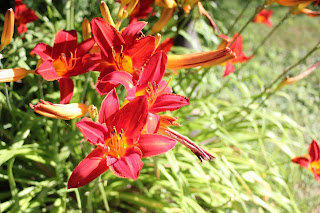I bought this adorable smoke bush, you see, and I need a spot to put it. After my husband getting mad at me for wanting to put a shrub that grows really big on top of the weeping bed, I decided to plant it elsewhere, but I still wanted that new bed.
So here is the least strenuous way to make a new bed:
First, decide where the bed should go: notice how much light the location gets, and that will determine what type of plants you can use. Don't put sun lovers in a shady spot, or they won't grow to their full potential.
Then, decide on the shape of the bed. Use rope, hose, or a long electrical cord like I did to rough out the shape.
Then, cut out the sod around the outside of the new bed.
Instead of the back breaking work of taking off all the sod, just plot out where you want the plants. With a bed that can be seen from all sides, but the tall plants in the centre, and shorter ones on the outside. Keep in mind the mature height of the plants, not what they look like right now.
Dig holes for each plant, augmenting some of the soil with well-rotted manure. Water really well, especially if you are foolish enough to try this in the long hot days of summer.
I was going to buy new plants for this bed, but I had so much growing in my current beds that was getting very crowded. The purple coneflower and the daylily were growing in the shade, the three hardy hybiscus were hidden by other plants, and the ornamental grasses were divided from current clumps. The grasses have very small root balls, and were really easy to dig up.
When all the plants are in, cover the area with newspapers to prevent light from reaching the grass. Do this in small sections on a day with no wind, or you will be papering the neighbourhood. Wet the paper to keep it from blowing away.
I went to the beach (I have a secret spot) with lots of eelgrass drying on the shore, which is a perfect mulch - it adds nutrients to the soil as it slowly breaks down, and it's FREE.
It takes a surprizingly huge amount of seaweed to mulch this bed, but after piling it on top of the newspapers, it looks great, and the bed is done. The mulch will flatten down in time. The new plantings should be watered every few days to keep them thriving.















